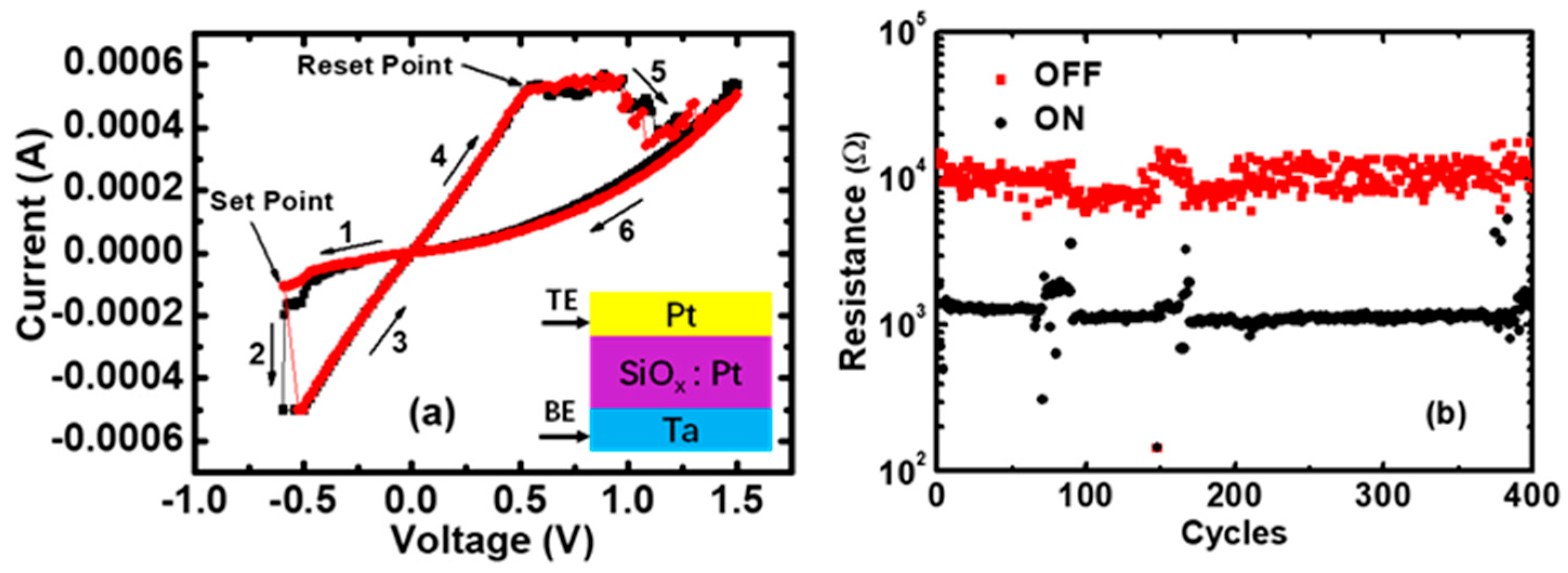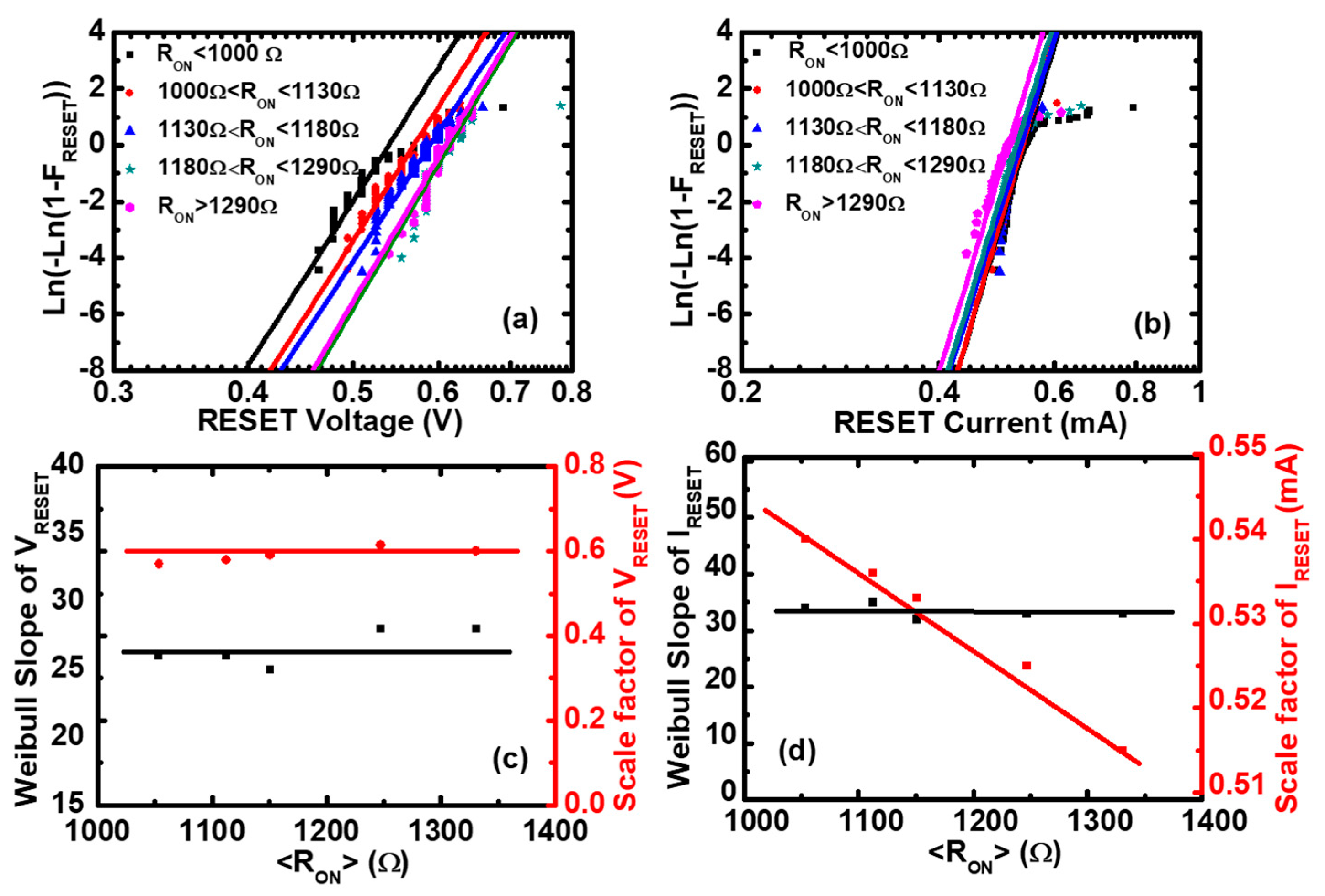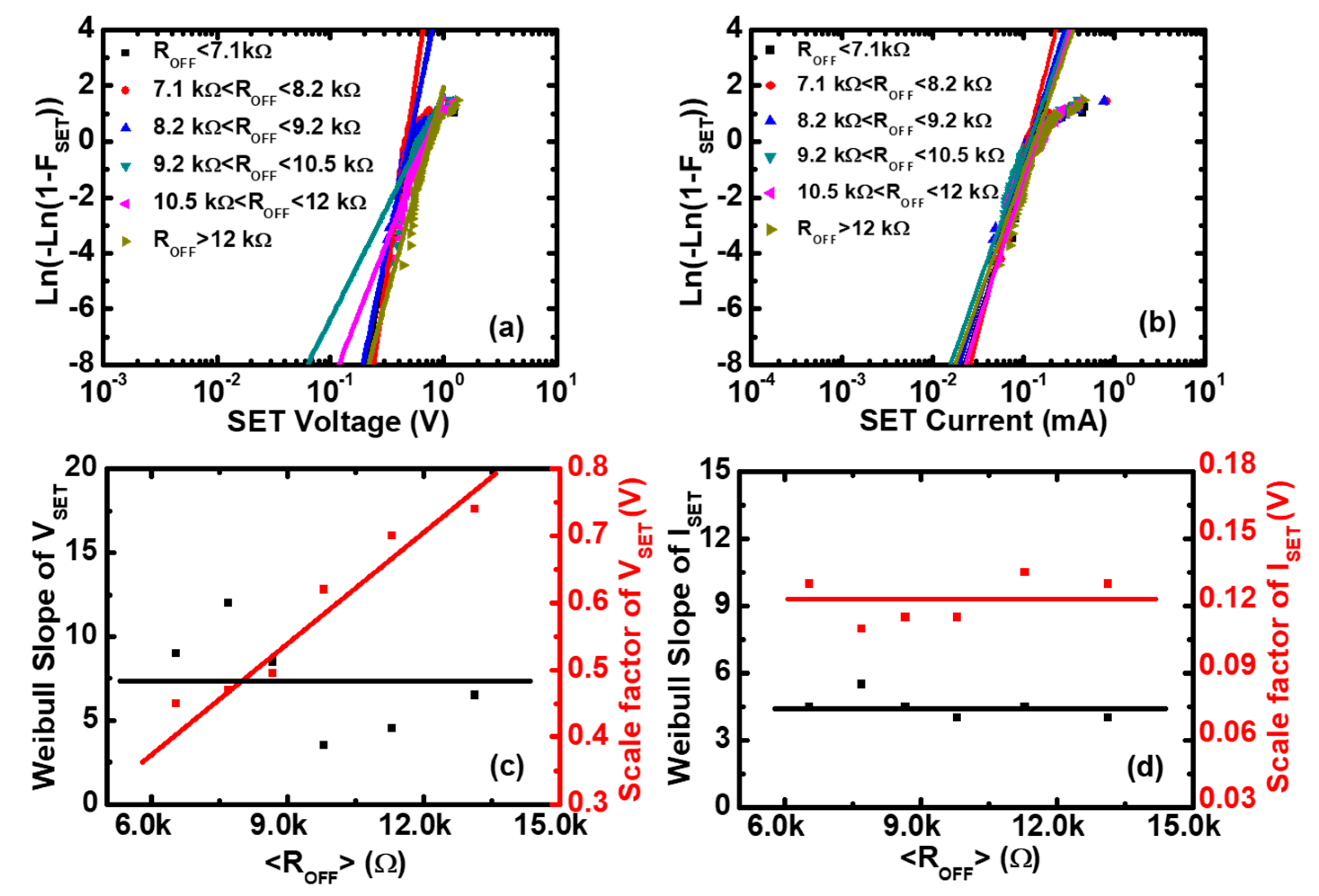Resistance Switching Statistics and Mechanisms of Pt Dispersed Silicon Oxide-Based Memristors
Abstract
:1. Introduction
2. Materials and Methods
3. Results
3.1. Statistical Distributions
3.2. Quantum Point Contact Model
4. Discussion
Author Contributions
Funding
Acknowledgments
Conflicts of Interest
References
- Chua, L.O. Memristor-the missing circuit element. IEEE Trans. Circuit Theory 1971, 18, 507–519. [Google Scholar] [CrossRef]
- Chua, L.O.; Kang, S.M. Memristive devices and systems. Proc. IEEE 1976, 64, 209–223. [Google Scholar] [CrossRef]
- Waser, R.; Aono, M. Nanoionics-Based Resistive Switching Memories. Nat. Mater. 2007, 6, 833–840. [Google Scholar] [CrossRef] [PubMed]
- Strukov, D.B.; Snider, G.S.; Stewart, D.R.; Williams, R.S. The missing memristor found. Nature 2008, 453, 80–83. [Google Scholar] [CrossRef] [PubMed]
- Sawa, A. Resistive switching in transition metal oxides. Mater. Today 2008, 11, 28–36. [Google Scholar] [CrossRef]
- Chua, L.O. Resistance switching memories are memristors. Appl. Phys. A Mater. Sci. Process. 2011, 102, 765–783. [Google Scholar] [CrossRef] [Green Version]
- Yang, J.J.; Pickett, M.D.; Li, X.; Ohlberg, D.A.A.; Stewart, D.R.; Williams, R.S. Memristive switching mechanism for metal/oxide/metal nanodevices. Nat. Nanotechnol. 2008, 3, 429–433. [Google Scholar] [CrossRef]
- Wong, H.-S.P.; Lee, H.-Y.; Yu, S.; Chen, Y.-S.; Wu, Y.; Chen, P.-S.; Lee, B.; Chen, F.T.; Tsai, M.-J. Metal–Oxide RRAM. Proc. IEEE 2012, 100, 1951–1970. [Google Scholar] [CrossRef]
- Xia, Q.F.; Robinett, W.; Cumbie, M.W.; Banerjee, N.; Cardinali, T.J.; Yang, J.J.; Wu, W.; Li, X.M.; Tong, W.M.; Strukov, D.B.; et al. Memristor-CMOS hybrid integrated circuits for reconfigurable logic. Nano Lett. 2009, 9, 3640–3645. [Google Scholar] [CrossRef]
- Jo, S.H.; Chang, T.; Ebong, I.; Bhadviya, B.B.; Mazumder, P.; Lu, W. Nanoscale memristor device as synapse in neuromorphic systems. Nano Lett. 2010, 10, 1297–1301. [Google Scholar] [CrossRef] [PubMed]
- Lee, M.-J.; Lee, C.B.; Lee, D.; Lee, S.R.; Chang, M.; Hur, J.H.; Kim, Y.-B.; Kim, C.-J.; Seo, D.H.; Seo, S.; et al. A fast, high-endurance and scalable non-volatile memory device made from asymmetric Ta2O5−x/TaO2−x bilayer structures. Nat. Mater. 2011, 10, 625–630. [Google Scholar] [CrossRef]
- Chen, W.; Fang, R.; Balaban, M.B.; Yu, W.; Velo, Y.G.; Barnaby, H.J.; Kozicki, M.N. A CMOS-compatible electronic synapse device based on Cu/SiO2/W programmable metallization cells. Nanotechnology 2016, 27, 255202. [Google Scholar] [CrossRef] [PubMed]
- Burgt, Y.; Lubberman, E.; Fuller, E.J.; Keene, S.T.; Faria, G.C.; Agarwal, S.; Marinella, M.J.; Talin, A.A.; Salleo, A. A non-volatile organic electrochemical device as a low-voltage artificial synapse for neuromorphic computing. Nat. Mater. 2017, 16, 414–418. [Google Scholar] [CrossRef]
- Hu, M.; Graves, C.E.; Li, C.; Li, Y.; Ge, N.; Montgomery, E.; Davila, N.; Jiang, H.; Williams, R.S.; Yang, J.; et al. Memristor-Based Analog Computation and Neural Network Classification with a Dot Product Engine. Adv. Mater. 2018, 30, 1705914. [Google Scholar] [CrossRef] [PubMed]
- Li, C.; Belkin, D.; Li, Y.; Yan, P.; Hu, M. Efficient and self-adaptive in-situ learning in multilayer memristor neural networks. Nat. Commun. 2018, 9, 2385. [Google Scholar] [CrossRef] [PubMed]
- Gavrilov, D.; Strukov, D.; Likharev, K.K. Capacity, Fidelity, and Noise Tolerance of Associative Spatial-Temporal Memories Based on Memristive Neuromorphic Networks. Front. Neurosci. 2018, 12, 195. [Google Scholar] [CrossRef] [PubMed]
- Bayat, F.M.; Prezioso, M.; Chakrabarti, B.; Nili, H.; Kataeva, I.; Strukov, D. Implementation of multilayer perceptron network with highly uniform passive memristive crossbar circuits. Nat. Commun. 2017, 9, 2331. [Google Scholar] [CrossRef]
- Li, D.; Wu, B.; Zhu, X.; Wang, J.; Ryu, B.; Lu, W.D.; Lu, W.; Liang, X. MoS2 Memristors Exhibiting Variable Switching Characteristics towards Bio-Realistic Synaptic Emulation. ACS Nano 2018, 9, 9240–9252. [Google Scholar] [CrossRef]
- Zhu, X.; Lu, W.D. Optogenetics-Inspired Tunable Synaptic Functions in Memristors. ACS Nano 2018, 12, 1242–1249. [Google Scholar] [CrossRef]
- Shi, Y.; Liang, X.; Yuan, B.; Chen, V.; Li, H.; Hui, F.; Yu, Z.; Yuan, F.; Pop, E.; Wong, H.-S.P.; et al. Electronic synapses made of layered two-dimensional materials. Nat. Electron. 2018, 1, 458–465. [Google Scholar] [CrossRef]
- Zhao, Y.; Jiang, J.; Nanosci, J. Electronic synapses made of layered two-dimensional materials. Nanotechnol 2018, 18, 8003. [Google Scholar]
- Park, M.H.; Lee, Y.H.; Mikolajick, T.; Schroeder, U.; Hwang, C.S. Review and Perspective on Ferroelectric HfO2-based Thin Films for Memory Applications. MRS Commun. 2018, 8, 795–808. [Google Scholar] [CrossRef]
- Li, Y.; Han, K.; Kang, Y.; Kong, E.Y.J.; Gong, X. Extraction of Polarization-dependent Damping Constant for Dynamic Evaluation of Ferroelectric Films and Devices. IEEE Electron. Device Lett. 2018, 39, 1211–1214. [Google Scholar] [CrossRef]
- Li, Y.; Kang, Y.; Gong, X. Evaluation of Negative Capacitance Ferroelectric MOSFET for Analog Circuit Applications. IEEE Trans. Electron. Devices 2017, 64, 4317–4321. [Google Scholar] [CrossRef]
- Bricalli, A.; Ambrosi, E.; Laudato, M.; Maestro, M.; Rodriguez, R.; Lelmini, D. Resistive Switching Device Technology Based on Silicon Oxide for Improved ON-OFF Ratio—Part II: Select Devices. IEEE Trans. Electron. Devices 2018, 65, 122–128. [Google Scholar] [CrossRef]
- Liu, C.; Lin, C.; Liu, S.; Bai, C.; Zhang, Y. Improvement of switching uniformity in Cu/SiO2/Pt resistive memory achieved by voltage prestress. Jpn. J. Appl. Phys. 2015, 54, 031801. [Google Scholar] [CrossRef]
- Liu, C.; Huang, J.; Lai, C.; Lin, C. Influence of embedding Cu nano-particles into a Cu/SiO2/Pt structure on its resistive switching. Nanoscale Res. Lett. 2013, 8, 156. [Google Scholar] [CrossRef]
- Nandakumar, S.R.; Minvielle, M.; Nagar, S.; Dubourdieu, C.; Rajendran, B. A 250 mV Cu/SiO2/W Memristor with Half-Integer Quantum Conductance States. Nano Lett. 2016, 16, 1602–1608. [Google Scholar] [CrossRef]
- Mehonic, A.; Shluger, A.L.; Gao, D.; Valov, I.; Miranda, E.; Ielmini, D.; Bricalli, A.; Ambrosi, E.; Li, C.; Yang, J.J.; et al. Silicon Oxide (SiOx): A Promising Material for Resistance Switching? Adv. Mater. 2018, 30, 1801187. [Google Scholar] [CrossRef]
- Ng, W.H.; Mehonic, A.; Buckwell, M.; Montesi, L.; Kenyon, A.J. High-Performance Resistance Switching Memory Devices Using Spin-On Silicon Oxide. IEEE Trans. Nanotechnol. 2018, 17, 884–888. [Google Scholar] [CrossRef]
- Munde, M.S.; Mehonic, A.; Ng, W.H.; Buckwell, M.; Montesi, L.; Bosman, M.; Shluger, A.L.; Kenyon, A.J. Intrinsic Resistance Switching in Amorphous Silicon Suboxides: The Role of Columnar Microstructure. Sci. Rep. 2017, 7, 9274. [Google Scholar] [CrossRef] [PubMed]
- Mehonic, A.; Buckwell, M.; Montesi, L.; Munde, M.S.; Gao, D.; Hudziak, S.; Chater, R.J.; Fearn, S.; McPhail, D.; Bosman, M.; et al. Nanoscale Transformations in Metastable, Amorphous, Silicon-Rich Silica. Adv. Mater. 2016, 28, 7486–7493. [Google Scholar] [CrossRef] [PubMed] [Green Version]
- Tappertzhofen, S.; Valov, I.; Tsuruoka, T.; Hasegawa, T.; Waser, R.; Aono, M. Generic Relevance of Counter Charges for Cation-Based Nanoscale Resistive Switching Memories. ACS Nano 2013, 7, 6396–6402. [Google Scholar] [CrossRef] [PubMed]
- Tsuruoka, T.; Terabe, K.; Hasegawa, T.; Valov, I.; Waser, R.; Aono, M. Effects of Moisture on the Switching Characteristics of Oxide-Based, Gapless-Type Atomic Switches. Adv. Funct. Mater. 2012, 22, 70–77. [Google Scholar] [CrossRef]
- Yang, Y.; Gao, P.; Li, L.; Pan, X.; Tappertzhofen, S.; Choi, S.; Waser, R.; Valov, I.; Lu, W.D. Electrochemical dynamics of nanoscale metallic inclusions in dielectrics. Nat. Commun. 2014, 5, 4232. [Google Scholar] [CrossRef] [PubMed] [Green Version]
- Choi, B.J.; Torrezan, A.C.; Norris, K.J.; Miao, F.; Strachan, J.P.; Zhang, M.X.; Ohlberg, D.A.; Kobayashi, N.P.; Yang, J.J.; Williams, R.S. Electrical Performance and Scalability of Pt Dispersed SiO2 Nanometallic Resistance Switch. Nano Lett. 2013, 13, 3213–3217. [Google Scholar] [CrossRef]
- Choi, B.J.; Ge, N.; Yang, J.J.; Zhang, M.-X.; Williams, R.S.; Norris, K.J.; Kobayashi, N.P. New materials for memristive switching. IEEE Int. Symp. Circuits Syst. (ISCAS) 2014, 10, 2808–2811. [Google Scholar]
- Lian, X.; Wang, M.; Yan, P.; Yang, J.J.; Miao, F. Reset switching statistics of TaOx-based Memristor. J. Electroceram. 2017, 39, 132–136. [Google Scholar] [CrossRef]
- Long, S.; Lian, X.; Cagli, T.; Ye, C.; Perniola, L.; Miranda, E.; Liu, M.; Sune, J. Cycle-to-Cycle Intrinsic RESET Statistics in HfO2-Based Unipolar RRAM. IEEE Electron. Device Lett. 2013, 34, 623–625. [Google Scholar] [CrossRef]
- Lian, X.; Miao, F.; Wan, X.; Guo, Y.-F.; Tong, Y.; Electroceram, J. Set transition statistics of different switching regimes of TaOx memristor. J. Electroceram. 2019. [Google Scholar] [CrossRef]
- Michalas, L.; Stathopoulos, S.; Khiat, A.; Prodromakis, T. Conduction mechanisms at distinct resistive levels of Pt/TiO2−x/Pt memristors. Appl. Phys. Lett. 2018, 113, 143503. [Google Scholar] [CrossRef]
- Chen, K.-H.; Tsai, T.-M.; Cheng, C.-M.; Huang, S.-J.; Chang, K.-C.; Liang, S.-P.; Young, T.-F. Schottky Emission Distance and Barrier Height Properties of Bipolar Switching Gd:SiOx RRAM Devices under Different Oxygen Concentration Environments. Materials 2017, 11, 43. [Google Scholar] [CrossRef] [PubMed]
- Gul, F. Carrier transport mechanism and bipolar resistive switching behavior of a nano-scale thin film TiO2 memristor. Ceram. Int. 2018, 44, 11417–11423. [Google Scholar] [CrossRef]
- Gismatulin, A.A.; Kruchinin, V.N.; Gritsenko, V.A.; Prosvirin, I.P.; Yen, T.-J.; Chin, A. Charge transport mechanism of high-resistive state in RRAM based on SiOx. Appl. Phys. Lett. 2019, 114, 033503. [Google Scholar] [CrossRef]
- Bersuker, G.; Gilmer, D.C.; Veksler, D.; Kirsch, P.; Vandelli, L.; Padovani, A.; Larcher, L.; McKenna, K.; Shluger, A.; Iglesias, V.; et al. Metal oxide resistive memory switching mechanism based on conductive filament properties. J. Appl. Phys. 2011, 110, 124518. [Google Scholar] [CrossRef]
- Yan, X.; Zhou, Z.; Ding, B.; Zhao, J.; Zhang, Y. Superior resistive switching memory and biological synapse properties based on a simple TiN/SiO2/p-Si tunneling junction structure. J. Mater. Chem. C 2017, 5, 2259–2267. [Google Scholar] [CrossRef]
- Yu, S.; Guan, X.; Wong, H.-S.P. Conduction mechanism of TiN/HfOx/Pt resistive switching memory: A trap-assisted-tunneling model. Appl. Phys. Lett. 2011, 99, 063507. [Google Scholar] [CrossRef]
- Chang, K.-C.; Tsai, T.-M.; Chang, T.-C.; Wu, H.-H.; Chen, J.-H.; Syu, Y.-E.; Chang, G.-W.; Chu, T.-J.; Liu, G.-R.; Su, Y.-T.; et al. Characteristics and Mechanisms of Silicon-Oxide-Based Resistance Random Access Memory. IEEE Electron. Device Lett. 2013, 34, 399–401. [Google Scholar] [CrossRef]
- Kim, K.M.; Choi, B.J.; Shin, Y.C.; Choi, S.; Hwang, C.S. Anode-interface localized filamentary mechanism in resistive switching of TiO2 thin films. Appl. Phys. Lett. 2007, 91, 012907. [Google Scholar] [CrossRef]
- Hsieh, W.-K.; Lam, K.-T.; Chang, S.-J. Characteristics of tantalum-doped silicon oxide-based resistive random access memory. Mater. Sci. Semicond. Process. 2014, 27, 293–296. [Google Scholar] [CrossRef]
- Sun, C.; Lu, S.M.; Jin, F.; Mo, W.Q.; Song, J.L.; Dong, K.F. The Resistive Switching Characteristics of TiN/HfO2/Ag RRAM Devices with Bidirectional Current Compliance. J. Electron. Mater. 2019, 48, 2992–2999. [Google Scholar] [CrossRef]
- Liu, M.; Abid, Z.; Wang, W.; He, X.; Liu, Q.; Guan, W. Multilevel resistive switching with ionic and metallic filaments. Appl. Phys. Lett. 2009, 94, 233106. [Google Scholar] [CrossRef] [Green Version]
- Kunchur, M.N.; Liang, M.; Gurevich, A. Thermally activated dynamics of spontaneous perpendicular vortices tuned by parallel magnetic fields in thin superconducting films. Phys. Rev. B 2012, 86, 024521. [Google Scholar] [CrossRef]
- Graves, C.E.; Dávila, N.; Merced-Grafals, E.J.; Lam, S.-T.; Strachan, J.P.; Williams, R.S. Temperature and field-dependent transport measurements in continuously tunable tantalum oxide memristors expose the dominant state variable. Appl. Phys. Lett. 2017, 110, 123501. [Google Scholar] [CrossRef]
- Miranda, E.; Mehonic, A.; Ng, W.H.; Kenyon, A.J. Simulation of Cycle-to-Cycle Instabilities in SiOx- Based ReRAM Devices Using a Self-Correlated Process with Long-Term Variation. IEEE Electron. Device Lett. 2018, 40, 28–31. [Google Scholar] [CrossRef]
- Holloway, G.W.; Ivanov, O.; Gavrilov, R.; Bluschke, A.G.; Hold, B.K.; Baugh, J. Electrical Breakdown in Thin Si Oxide Modeled by a Quantum Point Contact Network. IEEE Trans. Electron. Devices 2016, 63, 3005–3010. [Google Scholar] [CrossRef]
- Sune, J.; Miranda, E.; Nafria, M.; Aymerich, X. Point contact conduction at the oxide breakdown of MOS devices. In Proceedings of the International Electron Devices Meeting 1998, Technical Digest (Cat. No.98CH36217), San Francisco, CA, USA, 6–9 December 1998. [Google Scholar]
- Sune, J.; Miranda, E. Understanding soft and hard breakdown statistics, prevalence ratios and energy dissipation during breakdown runaway. In Proceedings of the International Electron Devices Meeting, Technical Digest (Cat. No.01CH37224), Washington, DC, USA, 2–5 December 2001. [Google Scholar]
- Lian, X.; Cartoixà, X.; Miranda, E.; Perniola, L.; Rurali, R.; Long, S.; Liu, M.; Suñé, J. Multi-scale quantum point contact model for filamentary conduction in resistive random access memories devices. J. Appl. Phys. 2014, 115, 244507. [Google Scholar] [CrossRef]
- Zhang, M.; Long, S.; Wang, G.; Xu, X.; Li, Y.; Liu, Q.; Lv, H.; Lian, X.; Miranda, E.; Suñé, J.; et al. Set statistics in conductive bridge random access memory device with Cu/HfO2/Pt structure. Appl. Phys. Lett. 2014, 105, 193501. [Google Scholar] [CrossRef]
- Lian, X.; Wang, M.; Rao, M.; Yan, P.; Yang, J.J.; Miao, F. Characteristics and transport mechanisms of triple switching regimes of TaOx memristor. Appl. Phys. Lett. 2017, 110, 173504. [Google Scholar] [CrossRef]
- Datta, S. Electronic Transport in Mesoscopic Systems; University of Cambridge: Cambridgeshire, UK, 1997. [Google Scholar]
- Buttiker, M. Quantized transmission of a saddle-point constriction. Phys. Rev. B 1990, 41, 7906. [Google Scholar] [CrossRef]
- Bogachek, E.N.; Scherbakov, A.G.; Landman, U. Nonlinear magnetoconductance of nanowires. Phys. Rev. B 1997, 56, 14917. [Google Scholar] [CrossRef]
- Miranda, E.; Sune, J. From post-breakdown conduction to resistive switching effect in thin dielectric films. In Proceedings of the 2012 IEEE International Reliability Physics Symposium (IRPS), Anaheim, CA, USA, 15–19 April 2012; p. 367. [Google Scholar]
- Lübben, M.; Valov, I. Active Electrode Redox Reactions and Device Behavior in ECM Type Resistive Switching Memories. Adv. Electron. Mater. 2019, 1800933. [Google Scholar] [CrossRef]
- Valov, I.; Luebben, M.; Wedig, A.; Waser, R. Mobile Ions, Transport and Redox Processes in Memristive Devices. ECS Trans. 2016, 75, 27–39. [Google Scholar] [CrossRef]





© 2019 by the authors. Licensee MDPI, Basel, Switzerland. This article is an open access article distributed under the terms and conditions of the Creative Commons Attribution (CC BY) license (http://creativecommons.org/licenses/by/4.0/).
Share and Cite
Lian, X.; Shen, X.; Lu, L.; He, N.; Wan, X.; Samanta, S.; Tong, Y. Resistance Switching Statistics and Mechanisms of Pt Dispersed Silicon Oxide-Based Memristors. Micromachines 2019, 10, 369. https://doi.org/10.3390/mi10060369
Lian X, Shen X, Lu L, He N, Wan X, Samanta S, Tong Y. Resistance Switching Statistics and Mechanisms of Pt Dispersed Silicon Oxide-Based Memristors. Micromachines. 2019; 10(6):369. https://doi.org/10.3390/mi10060369
Chicago/Turabian StyleLian, Xiaojuan, Xinyi Shen, Liqun Lu, Nan He, Xiang Wan, Subhranu Samanta, and Yi Tong. 2019. "Resistance Switching Statistics and Mechanisms of Pt Dispersed Silicon Oxide-Based Memristors" Micromachines 10, no. 6: 369. https://doi.org/10.3390/mi10060369




